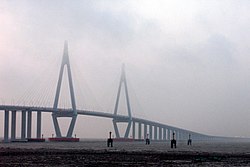Hangzhou Bay
 From Wikipedia - Reading time: 7 min
From Wikipedia - Reading time: 7 min

Hangzhou Bay[a] is a funnel-shaped inlet of the East China Sea on the middle eastern coast of Mainland China, bordered by the province of Zhejiang to the west and south, and the municipality of Shanghai to north. The bay extends westwards to its head at the city of Hangzhou, the provincial capital of Zhejiang, from which its name is derived. The east and southeast margin of Hangzhou Bay are marked by numerous islands off the shores of Ningbo, collectively called the Zhoushan Islands, which are an urbanized archipelago that forms the prefecture-level city of Zhoushan.
At Hangzhou, the Qiantang River flows into the bay, providing fresh water from the west, while seawater comes in from the east. Thus, Hangzhou Bay, especially its western end, is sometimes called the Qiantang River Estuary in the scientific literature.[1]
At less than 15 metres (49 ft) in depth, the Hangzhou Bay is relatively shallow. Consequently, the main port in the bay area is the Port of Ningbo-Zhoushan, the busiest ports in the world by cargo tonnage, at the southeast end of the bay striding between Ningbo and Zhoushan. The busiest container port in the world, the offshore Yangshan Port adminstered by the Port of Shanghai, is built on reclaimed land joining several small islands in a northwestern group of the Zhoushan Islands, which is connected to the mainland via the 32.5 km-long (20.2 mi) Donghai Bridge.
Qiantang River tidal bore
[edit]
The Bay is known for hosting the world's largest tidal bore, up to 9 meters (30 feet) high, and traveling up to 40 km (25 mi) per hour. Yanguan Town Tide-Viewing Park (盐官镇观潮胜地公园 Yánguān Zhèn Guāncháo Shèngdì Gōngyuán), on the north shore of Hangzhou Bay some 50 km east of the city of Hangzhou, is regarded as one of the best place to watch the Qiantang River Tidal Bore, especially on the 18th day of the eighth lunar month.[1][2]
Bay bridges
[edit]

The Bay was first spanned by the Hangzhou Bay Bridge, which was linked up on June 14, 2007, and opened on May 1, 2008. It is a long 35.7 km (22.2 mi) bridge carrying ![]() G15 expressway, three lanes each way, with two separate cable-stayed portions and a service center at the bridge midpoint. It runs across the mouth of Hangzhou Bay connecting the municipalities of Jiaxing and Ningbo in Zhejiang province. One of the longest bridges in the world, it cuts the trip between eastern Zhejiang and Shanghai from 400 to 80 kilometers (249 to 50 miles).
G15 expressway, three lanes each way, with two separate cable-stayed portions and a service center at the bridge midpoint. It runs across the mouth of Hangzhou Bay connecting the municipalities of Jiaxing and Ningbo in Zhejiang province. One of the longest bridges in the world, it cuts the trip between eastern Zhejiang and Shanghai from 400 to 80 kilometers (249 to 50 miles).

The second bridge crossing of the Bay is the Jiashao Bridge, located west of the Hangzhou Bay Bridge, and completed in 2013. It stretches 10.14 km (6.30 mi) across the Qiantang River estuary and carries the ![]() G15W expressway, four lanes each way, over six consecutive cable-stayed spans supported by six tall pylons. The Jiashao Bridge connects Shaoxing on the south shore of the Bay to a point on the north shore of the Bay due south of Jiaxing and provides a more direct route for vehicle traffic between Shaoxing and Shanghai.
G15W expressway, four lanes each way, over six consecutive cable-stayed spans supported by six tall pylons. The Jiashao Bridge connects Shaoxing on the south shore of the Bay to a point on the north shore of the Bay due south of Jiaxing and provides a more direct route for vehicle traffic between Shaoxing and Shanghai.
Another bridge is planned which will carry the Nantong–Ningbo high-speed railway.
Hangzhou Great Bay Area
[edit]In 2018, the Zhejiang provincial government, following in Guangdong's footsteps, released ambitious plans for the Hangzhou Great Bay Area, aiming for a mega urban re-development schema that would double the economic output of the region by 2022 and develop a “world class” bay area in Zhejiang by 2035. The Great Bay Area, an economic and industrial belt centered around Hangzhou Bay, is home to about 40 million people and, as of 2017, accounts for 87 percent of the province's economic output. The challenge to Zhejiang's vision may be its interaction with Shanghai.[3]
See also
[edit]Notes
[edit]- ^ Chinese: 杭州湾; pinyin: Hángzhōu Wān; Hangzhou Wu: han-tsei uae
References
[edit]- ^ a b Li, Ying; Pan, Dong-Zi; Chanson, Hubert; Pan, Cun-Hong (July 2019). "Real-time characteristics of tidal bore propagation in the Qiantang River Estuary, China, recorded by marine radar" (PDF). Continental Shelf Research. 180. Elsevier: 48–58. Bibcode:2019CSR...180...48L. doi:10.1016/j.csr.2019.04.012. S2CID 155917795.
- ^ "Qiantang River Tidal Bore". rove.me. Retrieved May 20, 2020.
- ^ Wang, Orange (May 2018). "Chinese province Zhejiang jumps on the Greater Bay Area bandwagon with its own ambitious regional blueprint". scmp.com. Retrieved May 22, 2020.
30°17′07″N 120°55′26″E / 30.2852°N 120.924°E
 KSF
KSF